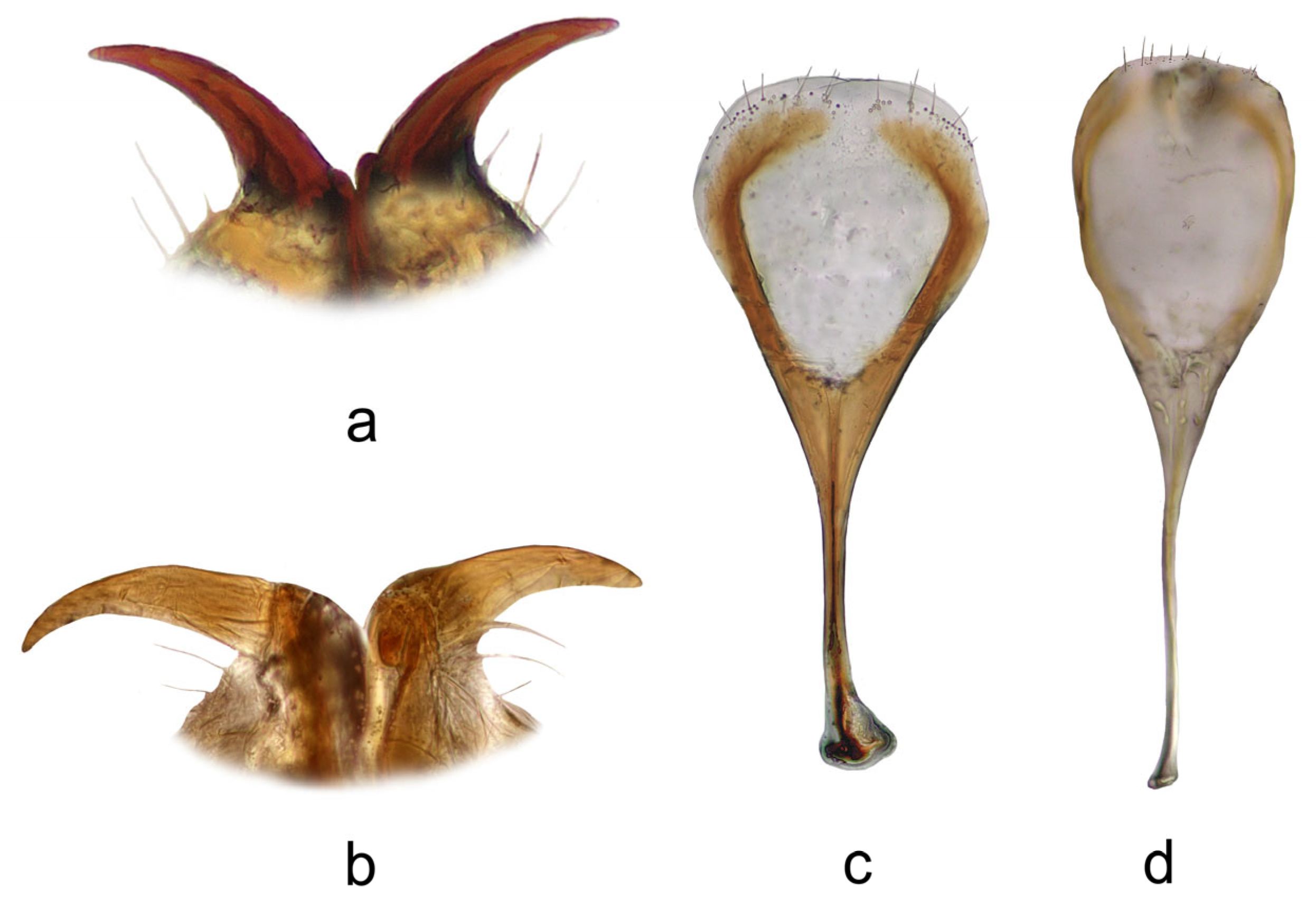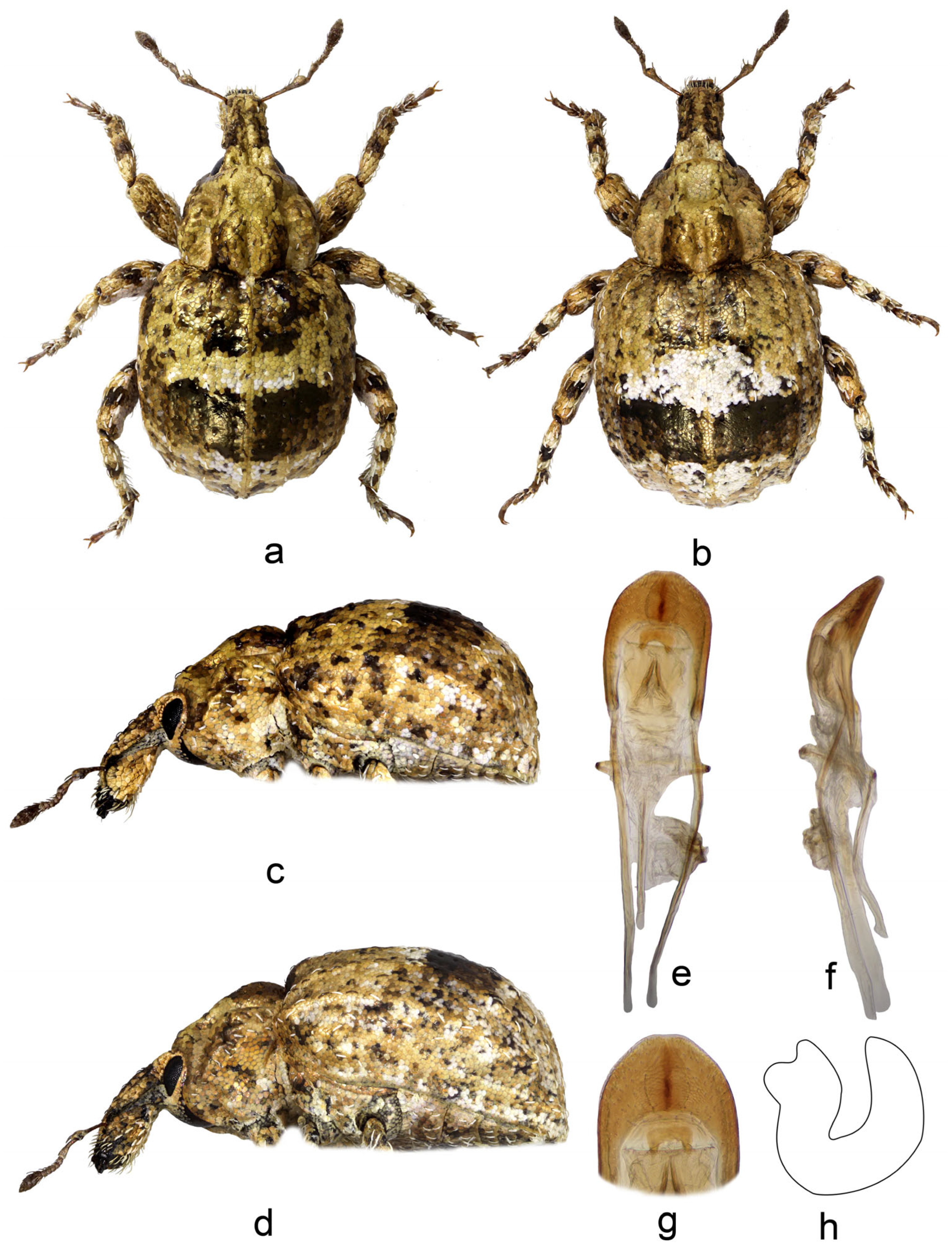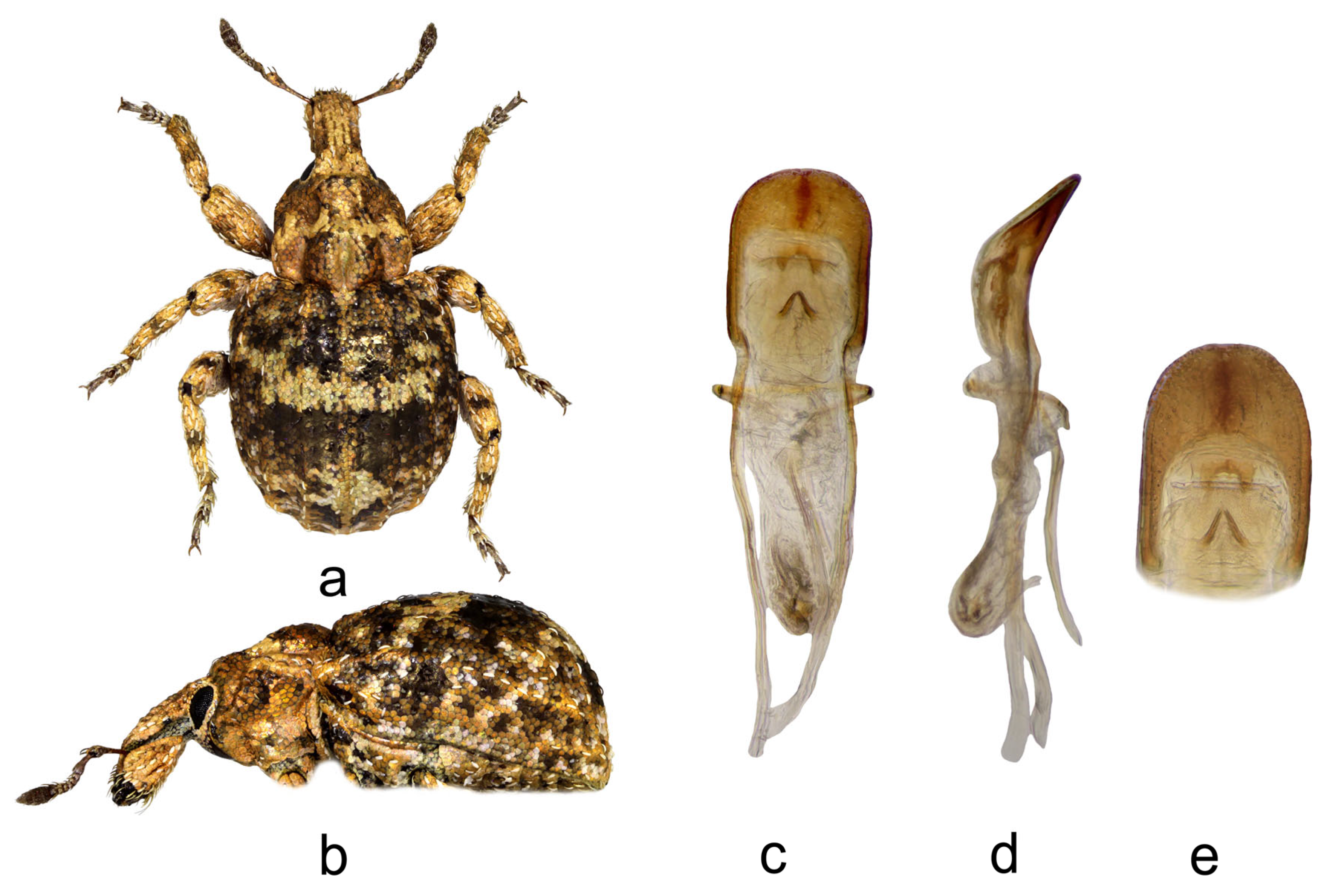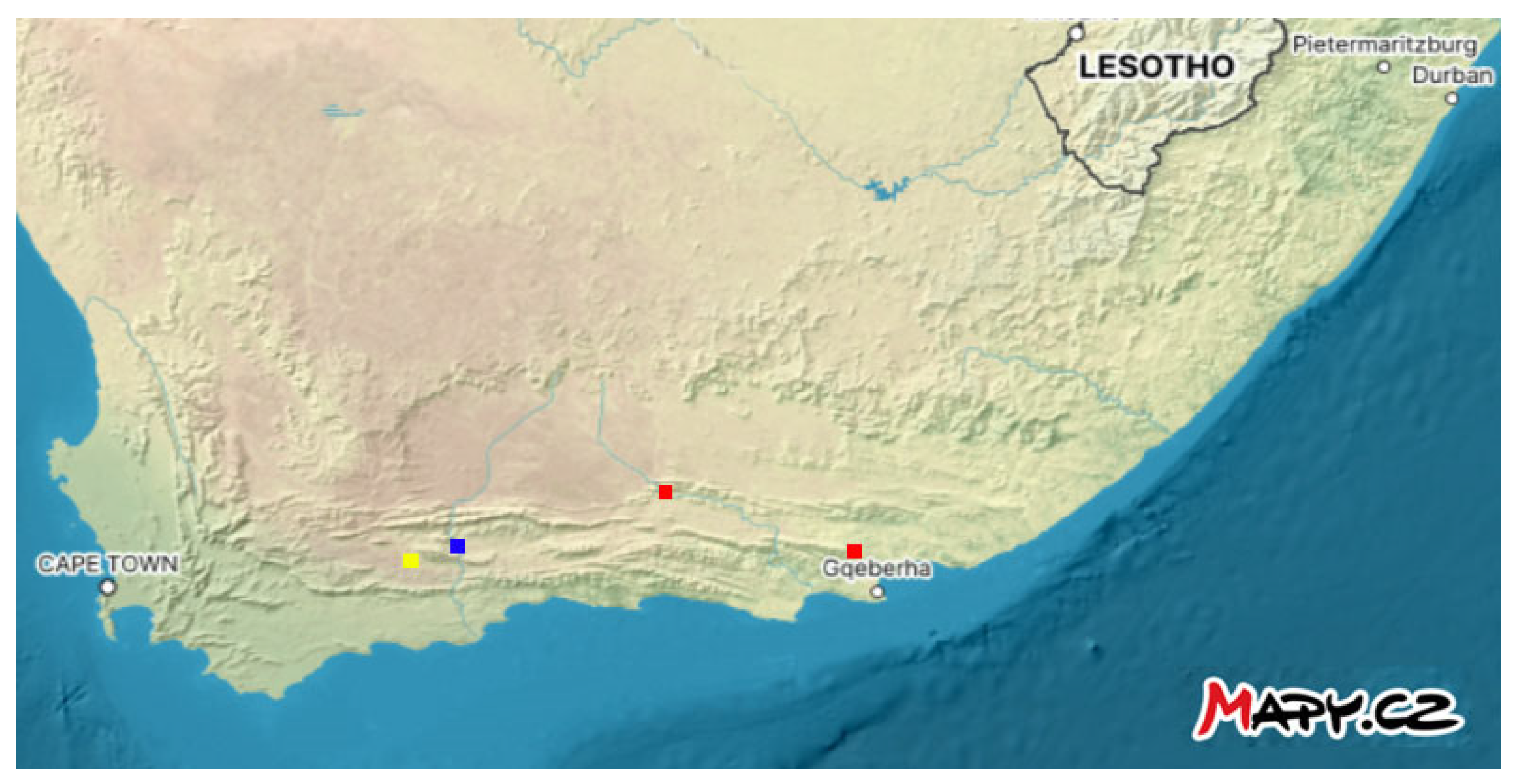3.1.2. Genus Characteristics
Redescription. Small Hipporhinini, 2.83–3.83 mm long, body subround, elytra at base only slightly wider than pronotum at base (Ewb/Pwb 1.10–1.25). Whole body including legs, rostrum, and venter except for antennae, tarsi, and medial part of head capsule in prosternal emargination covered with confluently, tile-like arranged, irregularly angular, partially imbricate, shiny to semi-shiny adpressed scales of various colors completely concealing integument; head including epifrons, pronotum, and elytra sparsely covered with adpressed to arch-like, elongate (l/w 4–6), shiny black and rarely intermixed white scales being on head and pronotum oriented anteriad, on elytra posteriad.
Rostrum longer than wide (Rl/Rw 1.5–2.1), epifrons with parallel sides, without protuberances above eyes, with two longitudinal carinae separated by medial sulcus being deepest at base, epistome relatively large, with suberect setae, mandibles bi- to oligosetose; scrobes medium long, divergent posteriad, their upper edge running toward middle of eye, lower edge toward lower eye margin. Antennal scape at apex clavate, with two strikingly long, erected spatula-shaped scales, funicle 7-segmented, segment 7 seemingly jointed with club, segment 1 always longer than segments 2–4 combined, segments 2–6 more or less isodiametric, segment 7 markedly transverse, all segments, especially segment 7, with more or less long setae, club spindle-shaped, pubescent, at most with very small setae. Eyes irregularly oval, almost flat.
Pronotum shorter than long, mediobasally with two large bulges separated by deep sulcus, in anterior part with two longitudinal ridges confluent with bulges in basal part, and delineating relatively deep but on bottom flat impression. Sides of pronotum with two very deep lateral and broad longitudinal impressions being at midlength interrupted by thin transverse ribs. Scutellum inapparent.
Elytra subglobose, in lateral view very strongly convex on disc, humeri small, without posthumeral impression. Odd interstriae at least in basal part of elytra vaulted, in apical part convex to flat. Striae formed by rows of anteriorly large and posteriorly smaller deep punctures narrower or as wide as interstriae.
Anterior margin of prosternum deeply emarginated, pre-coxal bridge of about 1/10 of prosternum length, slightly wider than post-coxal bridge, procoxal cavities broadly fused, their diameter usually larger than 0.7 of prosternum length; distance of metacoxal cavities measured from their inner margin about 2.2 × larger than the distance of mesocoxal cavities, mesosternal process flat, transverse, V1 always longer than V2, V5 of approximately same length as V3–4.
Legs robust, especially femora with preapical emargination, inner edge of tibiae sinuate, tarsi conspicuously thin, short, tarsomere 3 at most as wide as long, never widened, claws free, strongly divergent.
Male genitalia with tegmen without parameroid lobes, its diameter of half manubrium length, temones up to 2 × as long as median lobe, internal sack with several sclerites and rich structure. Female genitalia characterized by spermatheca with well developed ramus and nodulus, ovipositor with proximal gonocoxites large, laterally longly narrowly extended anteriad, distal gonocoxites (
Figure 1a,b) at apex with several setae, and with long, strong, claw-like, laterally curved sharp styli without setae, sternite VIII (
Figure 1c,d) cup-shaped.
Comparative notes. Plastologus is a unique genus in the tribe Hipporhinini. It differs from all other genera of this tribe in its globose, very convex body, elytra in dorsal view almost regularly rounded, without parallel or subparallel sections of their outline, elytral disc in lateral view, especially in females clearly convex. In some extent, this genus might be related to Gronops (Schoenherr, 1823) or Notogronops Marshall, 1821, especially due to the similar type of vestiture. However, both named genera have a very differently shaped body.
Biological notes. The biology of species in the genus is unknown. Adults were very rarely sifted from the litter under shrubs, especially those from the family Chenopodiaceae.
Distribution. This genus is endemic to South Africa, hitherto collected in the Western Cape and Eastern Cape provinces.
3.1.3. Treatment of Species
Plastologus costatus Boheman, 1842: 141 [
2]. Alonso-Zarazaga and Lyal, 1999: 142 [
5]. Oberprieler, 1999: 7 [
6].
Type locality. “Terra Caffrorum” (Eastern Cape, South Africa).
Type series. This species was described from an unspecified number of specimens. In coll. Schoenherr (NHRS) known to contain species described by Boheman, there was no specimen of P. costatus. Through the courtesy of J. Bergsten I was informed that the type of P. costatus was taken on loan by S. Louw (BMSA) a long time ago, who in the meantime has passed away. In 2022, I visited BMSA, and with the help of B. Muller, we found one complete but pinned and therefore damaged, 3.79 mm long male labeled “Caffra-ria./Typus [printed red label]/359 85/Riksmuseum Stockholm/Plastologus costatus [newly added large handwritten label]” perfectly corresponding to Boheman’s description. For clarity, I labeled this specimen with the printed red label “HOLOTYPUS Plastologus costatus Boheman Michael Košťál vid. 2024”. The holotype will be returned to NHRS.
Synonyms. None.
Redescription. Male. Body stout, subround. Head: Rostrum medium long (Rl/Pl 0.8), stout (Rl/Rw 2.1), black, in lateral view unevenly moderately curved, slightly widened from base to antennal insertion, then strongly tapered to apex; in dorsal view parallel to shortly behind base, then abruptly widened due to prominent lower scrobe edge and moderately widened to antennal insertion, then markedly tapered to apex; longitudinal carinae on epifrons prominent. Head between eyes broad, with deep, narrow longitudinal impression. Antennae dark brown with somewhat paler basal part of scape, inserted before 0.7 of rostrum length, segment 1 as long as 1.4 × segments 2–4 combined, club about twice as long as wide. Pronotum: Black, wider than long (Pl/Pw 0.82), widest behind base, at about 1/3 of its length, sides in basal third rounded, then subconically narrowed anteriad, convex on disc; two large bulges in basal part not extraordinary prominent, moderately vaulted, their separating sulcus deep, relatively broad, two ridges delineating very deep impression in anterior part strongly prominent, two longitudinal broad impressions on sides interrupted by high transverse ribs sometimes almost reaching level of lateral part of pronotum. Elytra: Black, in dorsal view with almost regularly rounded sides; widest behind 1/3 of their length, at base moderately wider than pronotum (Ewb/Pwb 1.18), humeri round, slightly prominent; clearly convex on disc; interstriae much thinner than striae, as wide as 0.2–0.5 width of striae, odd interstriae except interstria 1markedly vaulted, especially in anterior part of elytra, interstria 3 at base with striking bulge, even interstriae very thin, irregular, compressed by large, irregularly chained punctures forming wide striae, puncture diameter only slightly diminishing toward apex; entire surface covered with adpressed shiny blackish to brownish scales, in about half of elytral length with relatively thin, transverse band of almost equal width, slightly arcuate posteriad, formed by adpressed whitish scales, apical 1/4 of elytra semidensely covered with same whitish scales. Prosternum: Anterior margin with very deep, strikingly broad, irregularly arcuate emargination. Venter: Mesosternal process transverse, 2.1 × as wide as long, flat, its anterior and posterior margins almost parallel and rectilinear; metasternum moderately concave; V1 in median part with moderate impression, V2 in anteromedian part flat, both ventrites with sparsely distributed, relatively large punctures, each with subrecumbent, elongate pale scale, suture between V1 and V2 clearly arcuate anteriad, V1 1.9 × as long as V2, V1–2 2.4 × as long as V3–4, V3–4 1.1 × as long as V5.
Legs: Blackish, apart from basic vestiture with subrecumbent to suberect, semisparsely distributed, elongate whitish scales.
Penis: Figure 2e–g, its body short, robust, with subparallel sides, apex in dorsal view with distinct emargination or incision, body in lateral view moderately arcuate, relatively thin.
Spermatheca: Figure 2h, corpus moderately massive, ramus and nodulus of approximately equal size, subparallel, cornu medium long, moderately bent.
Female. Elytra in lateral view very strongly convex on disc. Metasternum flat, V1 without impression.
Variability. Body length ♂♂ 2.98–3.79 mm, ♀♀ 3.00–3.73 mm. This species varies quite considerably in the color of the vestiture, some specimens may have transverse bands and the apical part of elytra covered instead of whitish with creamy scales, which can also reach lateral parts of elytra making thereby confluent the pale transverse band with the pale apical part of elytra. The structure of the pronotum and vaulted odd elytral interstriae vary to a minimum extent.
Diagnosis. This species is easily recognizable by the vaulted odd elytral interstriae from base to apex, the striae formed by large, almost confluent, irregularly spaced punctures, the lack of any shiny areas on the elytral disc, structure of the pronotum and the clearly incised apex of the penis.
Comparative notes. Out of the three known species in the genus, Plastologus costatus is most closely related to P. punctatus, from which it differs in the less stout rostrum, strikingly vaulted odd elytral interstriae being convex from base to apex, striae formed especially in basal part by large, deep, irregularly shaped, almost confluent punctures, and in the incised apex of the penis.
Biological notes. There are only few data on the biology of P. costatus. Based on data of the examined material, I can assume that the species is a litter dweller preferring dry bushy vegetation with predominating Chenopodiaceae.
Distribution. South Africa (Eastern Cape).
Non-type material examined. South Africa (Eastern Cape): Uitenhage (1, BMNH); Willowmore 16 km NE, 660 m, S33°9.6′ E23°35.2′, 7.xi.2023, leg. Košťál (5 ♂♂ 6 ♀♀ MKPC, 1 ♂ 2 ♀♀ RBPC, 1 ♀ TMSA); same data but 8.xi.2023 (2 ♀♀ MKPC, 1 ♂ RBPC).
Plastologus boroveci Košťál sp. n. (
Figure 3a–h)
LSID: urn:lsid:zoobank.org:act:D5999076-3653-486B-9B4F-24B87912177E
Type locality. Calitzdorp (Western Cape, South Africa).
Type series. Holotype: completely preserved, 3.63 mm long male with dissected genitalia in glycerol labeled “RSA Western Cape 301 m E Calitzdorp sifting 33°31.965′ S, 21°42.415′ E 6.xi.2011 R. Borovec leg./Sifted detritus and dead leaves below Chenopodiaceae shrubs/HOLOTYPUS Plastologus boroveci sp. n. Michael Košťál des. 2024 [printed red label] (NMPC). Paratypes (same designating label but instead “HOLOTYPUS” “PARATYPUS”): same labeling as holotype (6 ♂♂ 3 ♀♀ MKPC, 2 ♂♂ 2 ♀♀ RBPC); “RSA Western Cape 278 m E of Calitzdorp 33°31.965′ S, 21°42.415′ E R. Borovec lgt. 25.xi.2016/Sifted detritus and died leaves bellow Chenopodiaceae shrubs” (1 ♀ TMSA).
Description. Male. Body stout, subround.
Head: Rostrum medium long (Rl/Pl 0.8), stout (Rl/Rw 2.0), black, in lateral view its upper outline very slightly curved to antennal insertion, then abruptly slanting towards apex, its lower outline almost rectilinear from base to shortly before apex; in dorsal view sides of epifrons parallel to antennal insertion, widening of rostrum outline shortly behind its base due to prominent lower scrobe edge very slight to inapparent, from antennal insertion rostrum outline moderately tapered to apex; longitudinal carinae on epifrons moderately prominent. Head between eyes broadly deeply impressed. Antennae inserted behind 0.7 of rostrum length, their scape reddish-brown, segments and club dark brown, segment 1 as long as 1.4 × segments 2–4 combined, club about twice as long as wide.
Pronotum: Black, wider than long (Pl/Pw 0.81), widest in basal part at about 0.4 of its length, sides in basal half very slightly rounded, then slightly roundly narrowed anteriad, in lateral view in basal part vaulted, in apical part flat; two large bulges in basal part strongly vaulted, their separating sulcus narrow to moderately broad, two ridges delineating shallow impression in anterior part moderately prominent, two longitudinal broad impressions on sides interrupted by low, sometimes almost indistinct transverse ribs never reaching level of lateral part of pronotum.
Elytra: Black, in dorsal view subround, more slightly rounded in medial third; widest at 1/6 of their length, at base moderately wider than pronotum (Ewb/Pwb 1.25), humeri round, not prominent; moderately convex on disc; interstriae in basal part of equal width as striae, in apical part up to 2 × as wide as striae, all interstriae except interstria 3 being elevated at base flat to very slightly convex, striae formed by almost regular rows of medium deep, round punctures, puncture diameter substantially diminishing toward apex; entire surface covered with adpressed, shiny blackish, brownish to golden scales, before midlength with medium thick, almost rectilinear transverse band reaching from suture to interstria 9, and formed by adpressed whitish to creamy, often intermixed scales, apical 1/4 of elytra irregularly covered with same type of paler scales.
Prosternum: Anterior margin with very deep, U-shaped to arcuate emargination.
Venter: Mesosternal process rectangular, 1.8 × as wide as long, flat, its anterior margin very slightly arcuate, posterior margin rectilinear; metasternum very slightly concave; V1 in median part with impression, V2 in median part flat, both ventrites with sparsely distributed, large punctures, each with recumbent to subrecumbent, elongate pale scale, suture between V1 and V2 moderately arcuate anteriad, V1 1.3 × as long as V2, V1–2 2.6 × as long as V3–4, V3–4 as long as V5.
Legs: Blackish, apart from basic vestiture with suberect to erect, semidensely distributed, markedly elongate whitish scales.
Penis: Figure 3e–g, its body short, robust, with slightly rounded sides, apex in dorsal view truncate, body in lateral view moderately arcuate, relatively thick.
Spermatheca: Figure 2h, corpus moderately massive, ramus moderately larger than nodulus, slightly divergent, cornu medium long, thick, markedly bent.
Female. Elytra in lateral view very strongly convex on disc. Metasternum flat, V1 without impression.
Variability. Body length ♂♂ 2.87–3.80 mm, ♀♀ 3.27–3.83 mm. This species varies considerably in the color of the vestiture, some specimens have a transverse band and the apical part of elytra covered with shiny creamy to brown scales giving the elytra an almost unicolorous gold appearance. Other specimens, especially females, have the medial part of the transverse band enlarged into a triangular white macula strongly contrasting with the dark elytral vestiture behind the macula. The structure of the pronotum and elytra varies to a minimum extent, especially the form of striae and interstriae.
Diagnosis. This species is easily recognizable by the flat elytral interstriae, well separated, almost regularly spaced punctures forming striae, shiny area often present on elytral disc, and by the truncate apex of the penis.
Comparative notes. Plastologus boroveci is a unique species. It differs from P. costatus and P. punctatus in its relatively broad elytral interstriae being at least as wide as striae, in the posterior elytral area often twice as wide as striae, and in the truncate apex of the penis. Moreover, it differs from P. costatus in flat elytral interstriae.
Etymology. I name this species after its collector, my friend and colleague Roman Borovec, an eminent specialist in Palaearctic and Afrotropical Entiminae.
Biological notes. There is no data on the biology of this species except data on the type specimens I examined, which were sifted out from the litter under low bushes in a dry habitat.
Distribution. South Africa (Western Cape).
Non-type material examined. None.
Plastologus punctatus Košťál sp. n. (
Figure 4a–e)
LSID: urn:lsid:zoobank.org:act:83FC1130-0382-44EA-89A0-DE5BC5F412A7
Type locality. Ladismith (Western Cape, South Africa).
Type series. Holotype: completely preserved, 2.83 mm long male with dissected genitalia in glycerol labeled “RSA Western Cape 277 m S Ladismith to Riversdale 33°40.566′ S, 21°10.527′ E 27.x.2019 R. Borovec lgt./Sifted detritus and dead leaves below Chenopodiaceae shrubs/HOLOTYPUS Plastologus boroveci sp. n. Michael Košťál des. 2024 [printed red label] (NMPC).
Description. Male. Body stout, somewhat irregularly subround.
Head: Rostrum relatively short (Rl/Pl 0.9), remarkably stout (Rl/Rw 1.5), black, in lateral view widened from base to antennal insertion, then tapered to apex, its upper outline from base to antennal insertion almost rectilinear, then abruptly slanting to apex, lower outline to shortly before apex rectilinear; in dorsal view almost parallel from base to antennal insertion, lower scrobe edge almost not protruding from rostrum outline, from antennal insertion moderately tapered to apex; longitudinal carinae on epifrons only feebly visible. Head between eyes broad, with deep, relatively broad longitudinal impression. Antennae dark brown except reddish-brown scape, inserted at 0.7 of rostrum length, segment 1 1.3 × as long as segments 2–4 combined, club slightly less than twice as long as wide.
Pronotum: wider than long (Pl/Pw 0.79), widest at 0.4 of its length, sides up to 4/5 of its length subparallel, moderately irregular, then rounded anteriad, in lateral view in basal part vaulted, in apical part flat; two large bulges in basal part markedly vaulted, prominent, their separating sulcus deep, relatively broad, two ridges delineating shallow impression not prominent, two longitudinal broad impressions on sides interrupted by low, flat transverse ribs by far not reaching level of lateral part of pronotum.
Elytra: Black, in dorsal view with rounded sides; widest shortly before 1/3 of their length, at base very slightly wider than pronotum (Ewb/Pwb 1.10), humeri small, rounded, not prominent; convex on disc; interstriae, especially in anterior part, considerably thinner than striae, as wide as 0.5–0.8 width of striae, odd interstriae except interstria 1 slightly vaulted in same extent from base to apex, interstria 3 at base somewhat more vaulted but not forming bulge, even interstriae thin, in anterior part thinner and moderately irregular due to compression by large punctures forming striae, striae formed in anterior part by semidensely, somewhat irregularly chained, medium deep, well separated subround punctures being hardly smaller toward apex; entire surface covered with shiny black and bronzy scales, in about half of elytral length with transverse band similar to that in
P. costatus, in posterior part with irregular macula formed by same type of scales as transverse band reaching from interstria 1 to 5.
Prosternum: Anterior margin with very deep, round incision.
Venter: Mesosternal process rectangular, 1.6 × as wide as long, flat, its anterior margin slightly rounded, posterior margin emarginated; metasternum concave; V1 in median part with marked impression, V2 in anteromedian part flat, both ventrites with semidensely distributed, conspicuously large punctures, each with subrecumbent, elongate pale scale, suture between V1 and V2 moderately arcuate anteriad, V1 1.7 × as long as V2, V1–2 2.9 × as long as V3–4, V3–4 0.9 × as long as V5.
Legs: Blackish, apart from basic vestiture with recumbent to subrecumbent, semisparsely distributed, relatively short, thin pale scales.
Penis: Figure 4c–e, body robust, short, with almost parallel sides, apex in dorsal view broadly rounded, body in lateral view relatively thick.
Female. Unknown.
Variability. I know only the type specimen.
Diagnosis. This species can be recognized by the stout rostrum (Rl/Rw 1.5) with hardly noticeable longitudinal carinae on the epifrons, moderately vaulted odd elytral interstriae from the base to the apex, striae formed by subrounded, well separated, medium deep punctures along their entire length, and by the rounded apex of the penis in dorsal view.
Comparative notes. Plastologus punctatus is probably most closely related to P. costatus from which it differs in the stouter rostrum, only moderately vaulted odd elytral interstriae being slightly convex from base to apex, striae formed by medium large, subround, well separated, medium deep punctures, and in the regularly rounded apex of the penis. From P. boroveci, it differs strikingly in having vaulted elytral interstriae, stouter rostrum, and penis, which is not truncate at the apex.
Etymology. The Latin adjective “punctatus” meaning punctured refers to elytral interstriae formed by chained subrounded punctures.
Biological notes. No data.
Distribution. South Africa (Western Cape).
Non-type material examined. None.









